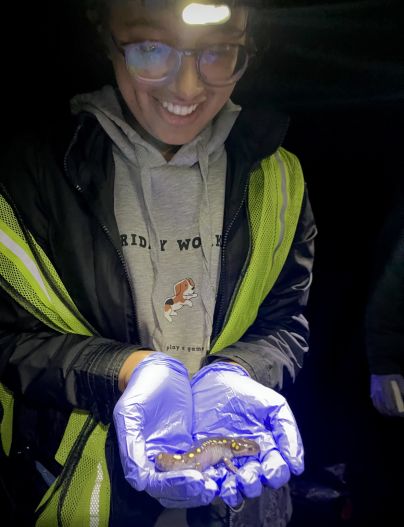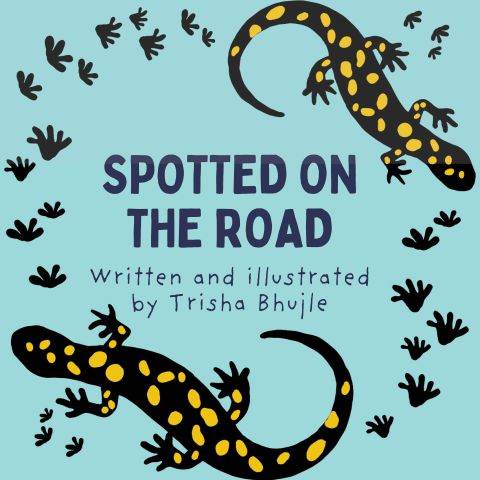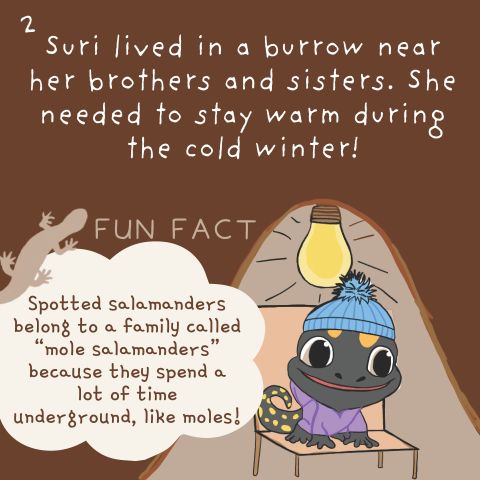Spotted on the Road: Migrations Scholar Shares Stories of Salamander Crossings

In Spotted on the Road Trisha Bhujle ’26 educates readers about spotted salamander migration. She began working on the children’s book as an Undergraduate Migrations Scholar last year.
Trisha studies environment and sustainability in the College of Agriculture and Life Sciences, with interests in wildlife conservation, climate change, and food systems. We interviewed Trisha about her work, her new book, and how we can all play a part in safer salamander migration.
How did you first get interested in salamanders and their migration?
I learned about spotted salamander migrations when I took “Wildlife Corridor Conservation and Crossing Design” in spring 2024 as my capstone class for the environment and sustainability major.
Laura Heady, the founder of the Amphibian Migrations and Road Crossings (AM&RC) Project, was one of the course’s many guest lecturers and offered critical insights on the importance of conservation planning for amphibians throughout the Hudson Valley. Instantly, I was captivated as she shared photos of spotted salamanders—so much so, that I soon decided to write a children’s book on their migration and ask Laura for her feedback!
Since that initial lecture, I’ve been fortunate to witness spotted salamanders up close. I recently joined Stephen Bredin, a graduate student studying amphibian road mortality and founder of the Tompkins County Amphibian Migration Patrol (TCAMP), to assist in monitoring amphibians on a stretch of road in Ithaca.
By disseminating information and recruiting volunteers to assist with amphibian migrations, TCAMP aims to raise awareness of local amphibians among residents of Tompkins and neighboring counties. TCAMP volunteers have already recorded over 4000 amphibians across three counties this spring.
It was eye-opening to witness firsthand the large number of amphibians killed by speeding cars, whose drivers were likely (and understandably) unaware of the hundreds of critters slowly migrating across the pavement. Two other students and I helped around 70 spring peepers, newts, and wood frogs safely cross the road, and we also learned how to monitor spotted salamander movements!
Every spring, spotted salamanders migrate from forests to vernal pools (also called woodland pools) to mate and lay their eggs. The pools also dry out during the summer, keeping out hungry fish that would otherwise eat salamander larvae.
-Spotted on the Road
What do you want people to know about salamanders and other amphibians on the move?
Amphibians are typically active when it is warm, dark, and wet outside. If you’re volunteering with TCAMP or AM&RC to help amphibians cross the road, remember to use a flashlight or headlamp and wear a neon vest that makes you more noticeable to drivers. Drivers may not see you or slow down for you. If you see a car, be sure to move off the road early!
While anyone can read and benefit from this book, I was specifically aiming to target elementary school kids through colorful illustrations and storytelling. I think it is incredibly important to teach kids about their surrounding environment starting from a young age.
How did being an undergraduate Migrations scholar shape you and your work?
The Migrations scholars program was so rewarding because of the diversity of thought that it welcomed. It is a rare privilege to be surrounded by students who share an interest in something but whose creative juices send each of them down differing paths.
My peers studied topics ranging from xenophobia to Southeast Asian refugees, and for my part, I was excited to offer an environmental lens to migration challenges. I learned so much about the world from my fellow scholars and their advice was invaluable as I furthered my own outputs.
How can others get involved?
If you’re interested in getting involved with the AM&RC Project, its website is a great place to start! It has detailed volunteer materials, forms to record data, and amphibian identification guides to enable volunteers to move amphibians across the road safely and appropriately.
To volunteer with TCAMP, join the Listserv or Facebook group. Volunteers will be provided with training videos, headlamps, high visibility vests, and other resources. Residents across other parts of the Finger Lakes region and beyond are also welcome to contact TCAMP for guidance on patrolling for amphibians!




